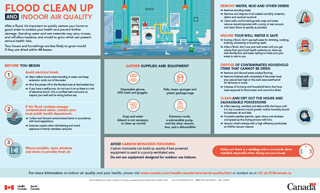Infographic: Flood clean up and indoor air quality

Download the alternative format
(PDF format, 387 Kb, 1 page)
- Organization: Health Canada
- Date published: 2021
After a flood, it's important to quickly restore your home to good order to protect your health and prevent further damage. Standing water and wet materials may carry viruses, and will allow bacteria, and mould to grow which can present serious health risks.
Your house and furnishings are less likely to grow mould if they are dried within 48 hours.
Before you begin
- Avoid electrical shock.
- Wear rubber boots when standing in water and keep extension cords out of the water.
- Shut the power off to the flooded area at the breaker box.
- If you have a well pump, do not turn it on as there is a risk of electrical shock. Hire a certified well contractor to inspect your well and its wiring before use.
- If the flood contains sewage-contaminated water, contact your local public health department.
- Collect and discard contaminated items in accordance with local regulations.
- Exercise caution when disinfecting and avoid exposure of family members and pets.
- Where possible, open windows and doors to provide fresh air.
Gather supplies and equipment:
- Disposable gloves, N95 mask and goggles
- Pails, mops, sponges and plastic garbage bags
- Soap and water. Bleach is not necessary to clean up mould
- Extension cords, submersible pump, wet/dry shop vacuum, fans and dehumidifier
Remove water, mud and other debris
- Remove standing water.
- Remove all soaked and dirty materials, debris and residual mud/soil.
- Clean walls and furnishings with a solution of soap and water, remove remaining water with a pump or wet vacuum, and clean floors as quickly as possible.
Ensure your well water is safe
- During a flood, don't use well water for drinking, cooking, bathing, showering or brushing teeth.
- After a flood, don't use your well water until you get advice from your local health authority on clean-up, well disinfection and water testing to make sure your water is safe to use.
Dispose of contaminated household items that cannot be dried
- Remove and discard water-soaked flooring.
- Remove finished walls completely if the water level was several feet high or the walls were wet/humid for 48 hours or more.
- Dispose of furniture and household items that have been exposed to flood water and cannot be dried.
Clean and dry out the house and salvageable possessions
- After cleaning, ventilate and dehumidify the house until it is dry to prevent mould growth. Indoor humidity should be between 30 and 50%.
- If outside weather permits, open doors and windows and speed up the drying process with fans.
- Vacuum dried surfaces with a high efficiency particulate air (HEPA) vacuum cleaner.
Avoid Carbon Monoxide Poisoning
Make sure there is a working carbon monoxide alarm installed, especially when drying out your house. Carbon monoxide can build up quickly if fuel-powered equipment is used in a poorly ventilated area. Do not use equipment designed for outdoor use indoors.
For more information, please visit indoor air quality and your health or contact us at: hc.air.sc@canada.ca
For more information, please visit get prepared.